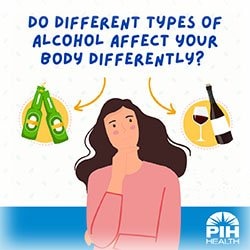Do Different Types of Alcohol Affect Your Body Differently?
 Many people feel differently when drinking different types of alcohol. But can different drinks really influence your mood in different ways?
Many people feel differently when drinking different types of alcohol. But can different drinks really influence your mood in different ways?
The fact is no matter what type of alcoholic beverage you drink—whether beer, wine, or spirits—they all contain the same ingredient that gets you intoxicated: ethanol. Ethanol is a by-product of fermenting natural sugars. Ethanol suppresses the central nervous system which means it slows the brain's functioning, affecting decision-making skills, slurring speech and impairing coordination.
“Since all types of alcohol contain the same intoxicating ingredient, other factors are likely contributing to how alcohol makes you feel,” says Mehwish Khan MD, PIH Health family medicine physician. “These may include how much alcohol you are consuming, your drinking behaviors, and other factors such as your age and existing medical conditions.”
Below are possible reasons you may feel differently depending on what you’re drinking:
Amount of alcohol by volume and Serving Size
Alcohol is metabolized in the liver by enzymes. However, the liver can only metabolize a small amount of alcohol at a time, leaving the excess alcohol to circulate throughout the body. The intensity of the effect of alcohol on the body is directly related to the amount consumed.
You may be consuming more alcohol when drinking one type of beverage than another, unless you pay careful attention to the serving size. This is because different alcoholic beverages have a different amount of alcohol by volume (ABV). The higher the ABV, the more alcohol content per fluid ounce. For example, the ABV of light beers may be around 3-5%, wine around 12-15% and whiskey around 40%.
A standard drink has 14 grams of ethanol in it. Depending on the alcohol’s ABV, the amount you can drink to meet this amount varies widely. For example, 14 grams of ethanol equals:
- 12 fluid ounces of beer with a 5% ABV
- 5 fluid ounces of wine with a 12% ABV
- 1.5 fluid ounces of spirits (vodka, run, gin, tequila or whiskey) with a 40% ABV
Many packaged drinks (in cans and bottles), as well as poured drinks in restaurants and bars, contain more than what is considered to be a standard drink.
Drinking Behaviors
- Atmosphere – Where you’re drinking and even who you're drinking with plays a part in how alcohol makes you feel. Are you sipping wine slowly while relaxing at home alone? Are you taking shots of tequila in a rowdy bar with friends? Are you chugging down a few beers while engrossed in an exciting football game?
- Time – How quickly you consume alcohol changes how it affects you. You’ll feel differently if you consume the same amount of alcohol over a short period of time than if it’s spaced out.
- Other consumption – Other things you’re consuming also influence how alcohol affects you. Are you eating food while you drink? Are you mixing alcohol with energy drinks or caffeine? Does your drink contain a lot of sugar? Are you also taking prescription or illicit drugs, such as depressants, stimulants or opioids?
Other Factors
- Intolerances – You may have an allergy or intolerance to ingredients used to make certain types of alcohol.
- Age – Your metabolism slows as you age, which may cause alcohol to have a greater effect on you.
- Medical conditions – Your overall health and the medications you take can affect how your body reacts to alcohol.
Talk to your doctor if you have any questions about alcohol consumption, especially if you have existing medical conditions or are taking medications. Visit PIHHealth.org/Find-A-Doctor to find to a PIH Health physician.
Copyright 2023 © Baldwin Publishing, Inc. Health eCooks™ is a designated trademark of Baldwin Publishing, Inc. Cook eKitchen™ is a designated trademark of Baldwin Publishing, Inc. Any duplication or distribution of the information contained herein without the express approval of Baldwin Publishing, Inc. is strictly prohibited.